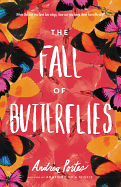 In her novel, The Fall of Butterflies, tells the story of Wilma, a young woman whose life hasn’t by any stretch of the imagination been easy. She’s never quite fit in, her mother has been absent, and her father struggles to support them. To make matters worse, her mother has decided that to be a proper adult, she has to abandon her hometown of What Cheer, Iowa for a pretentious private school on the East Coast. Consequently, Wilma plans to commit suicide once she arrives there.
In her novel, The Fall of Butterflies, tells the story of Wilma, a young woman whose life hasn’t by any stretch of the imagination been easy. She’s never quite fit in, her mother has been absent, and her father struggles to support them. To make matters worse, her mother has decided that to be a proper adult, she has to abandon her hometown of What Cheer, Iowa for a pretentious private school on the East Coast. Consequently, Wilma plans to commit suicide once she arrives there.
That is, until she meets Remy.
Remy is an enigma. She fascinates Wilma and breathes joy back into her life with her wit and friendship. For a while, they simply enjoy each other’s company. Remy sometimes disappears for days on end, but she also moves in with Wilma and pushes her to try new things and meet new people. However, Wilma soon learns that Remy has some very serious problems and some very dark secrets.
Portes tells Wilma’s story in a refreshingly frank tone by wasting no time beating around the bush and using very little figurative language. This technique works well, and makes Wilma seem more genuine. In addition to being painfully honest at times, The Fall of Butterflies is gripping to say the least, and Portes manages to make a story that addresses very real human concerns fun and light at times, while also solemn at others. Portes also raises questions about social issues such as the wealth gap and subsequent prejudices as Wilma watches the lives of her wealthy friends through the eyes of a child whose father worked very hard just to keep them afloat. The Fall of Butterflies also succeeds at character foils, both with Grease and Hamlet; although, it would have been better if Portes had not spent so much time explaining how the characters related and spent more time showing it.
This challenge is actually the key flaw in The Fall of Butterflies: Portes wastes too much time telling her reader when she should be showing them. She does paint a very vivid picture, but she leaves very little to the imagination. Most people are familiar enough with Hamlet to recognize that Remy shares many traits with Ophelia, and it would have been more elegant if she’d allowed the readers to make the connection for themselves. This problem persists throughout the entire book and follows nearly every pop culture reference made, which makes it tedious to read at times. Portes’s lack of a fourth wall also feels unnecessary and uncomfortable. All of the points Wilma made by speaking directly to the reader could have been made more gracefully if Portes had shown them implicitly through Wilma’s thoughts or actions. The final challenge The Fall of Butterflies faces is how to seem realistic. It’s very difficult for adults to genuinely sound like teenagers in young adult fiction, and Portes never really manages to bring Wilma the authentistic voice of a high schooler. She attempts to remedy this through use of pop culture references, such as “hashtags”, and long tangents about unnecessary things, but they only feel out of place and often break the flow of the story, making them more annoying than relatable. Even elements of the plot, such as Milo’s sudden interest in Wilma and the breakneck speed at which their relationship moves, are incredible. Frankly, it would have been much more believable for Remy and Wilma to fall in love than for Wilma to fall hopelessly in love with Milo because she saw him across the way once. Although the “love at first sight” trope has been successful in the past, many authors struggle to make it believable, and Portes never really achieves it.
In short, The Fall of Butterflies is witty and brutally honest, but was difficult to get through due to the aforementioned problems. Regardless, it is an interesting read for people who would like to explore themes such as acceptance of oneself and others, the class distinction and the issues that it causes, and what it means to live rather than to simply persist. – Paige P.
